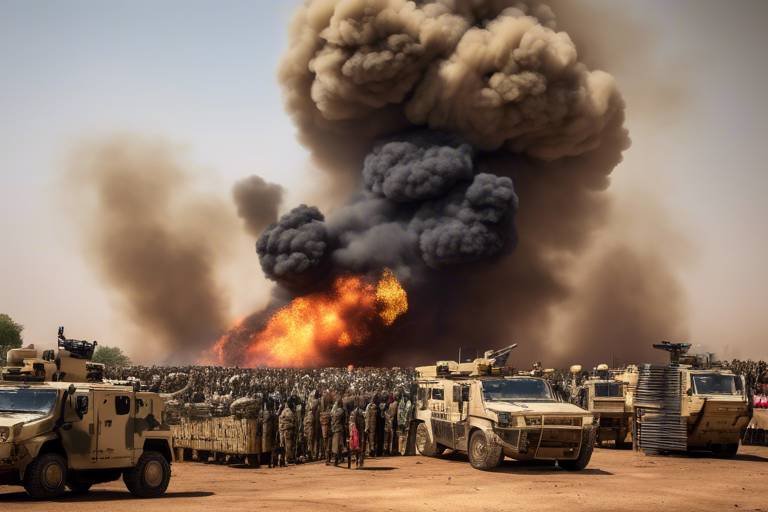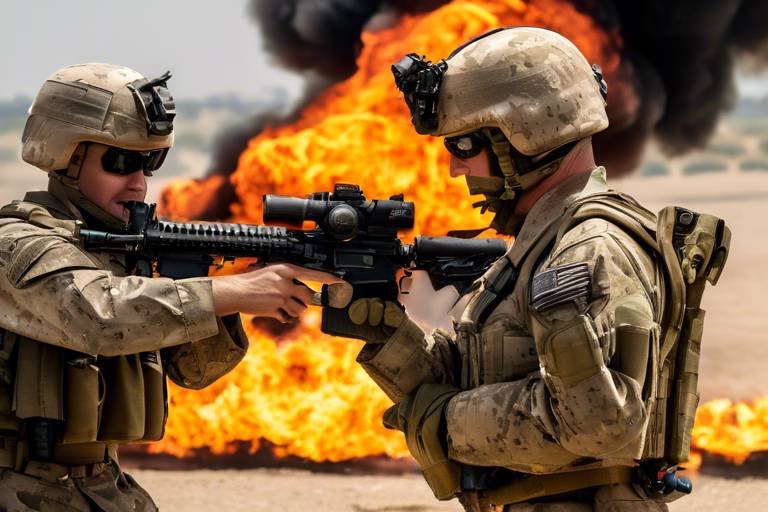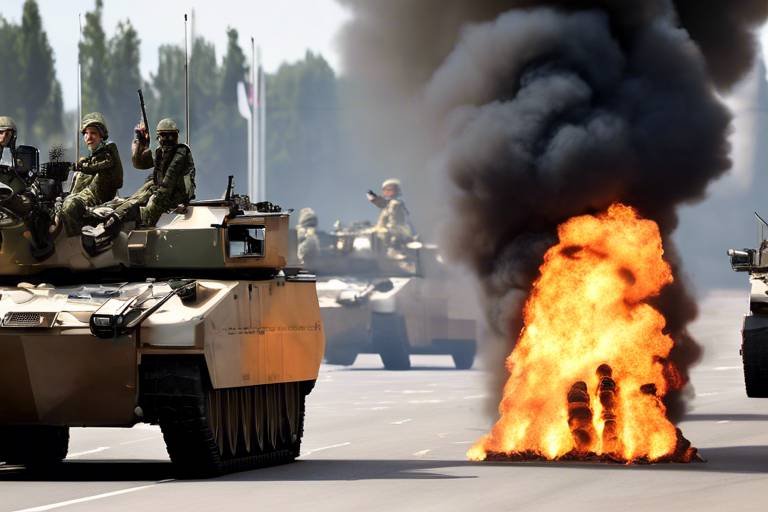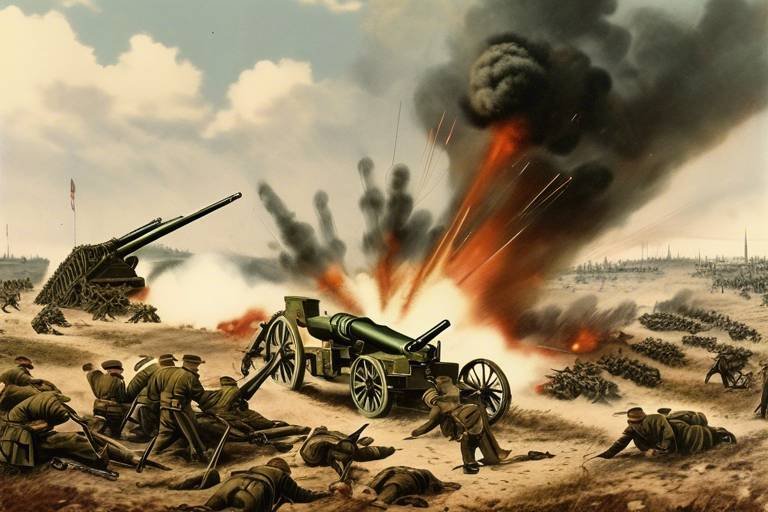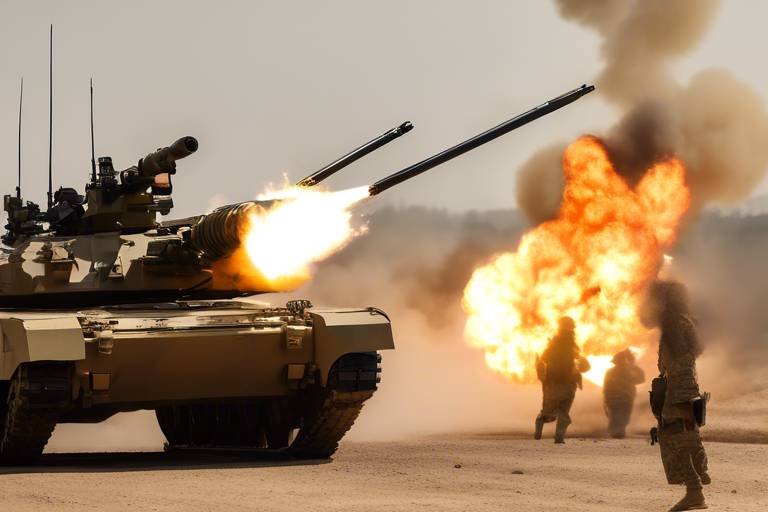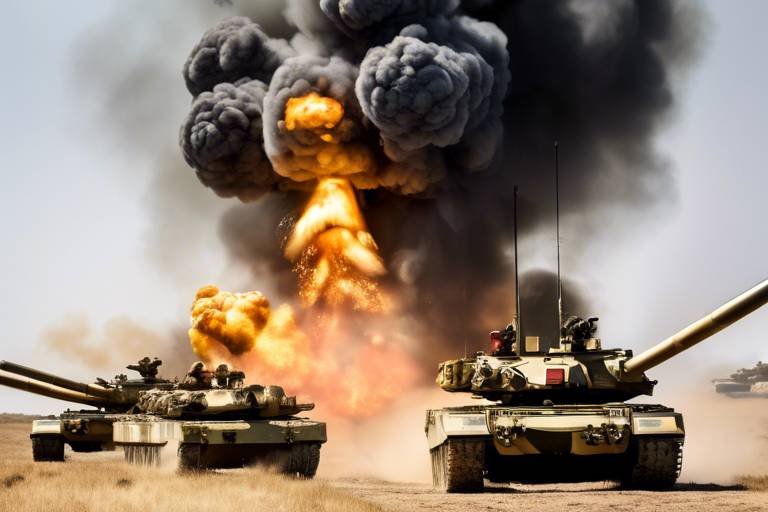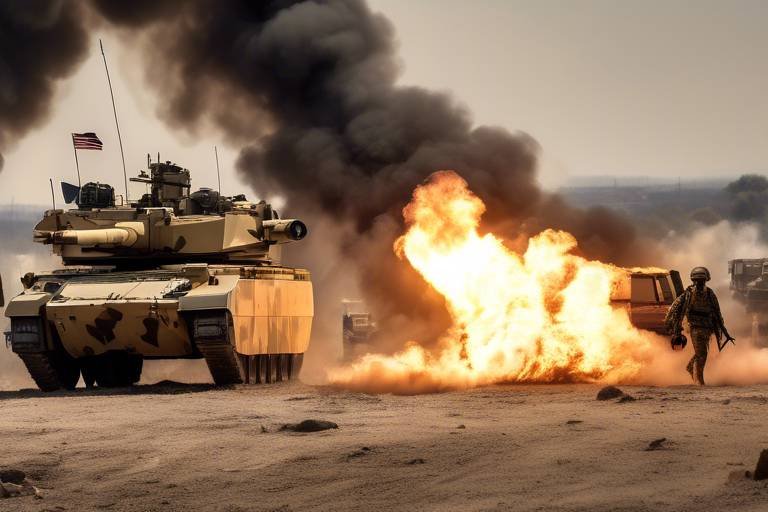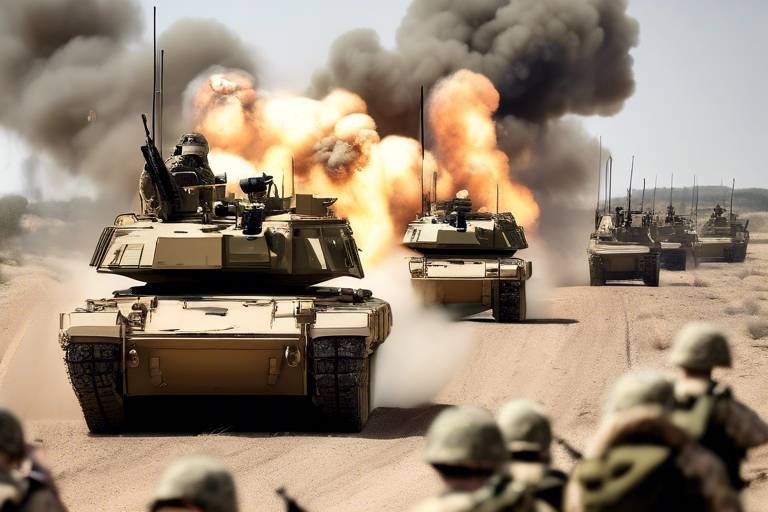How Urban Warfare is Shaping Future Weapon Technologies
Urban warfare is not just a tactical challenge; it’s a game changer in the realm of military technology. As cities become the battlegrounds of the 21st century, the need for advanced weapon systems tailored to these unique environments is more pressing than ever. Imagine a world where combat isn’t just about firepower but about precision, intelligence, and the ethical implications of warfare in populated areas. This article delves into how urban warfare is influencing the development of cutting-edge weapon technologies and the strategies that accompany them.
In recent years, urban warfare has emerged as a dominant form of conflict, characterized by its complexity and the dense population of combat zones. The rise of insurgencies, terrorism, and state conflicts in metropolitan areas has forced military forces to rethink their strategies. Gone are the days when battles were fought in open fields; now, soldiers find themselves navigating through alleys, high-rises, and civilian neighborhoods. This shift has spurred a wave of technological advancements aimed at addressing the unique challenges posed by urban environments. Understanding the dynamics of urban warfare is crucial for grasping the innovations that are transforming military operations.
The challenges of urban warfare have led to a surge in innovative weapon technologies. Military strategists are now focusing on tools that enhance effectiveness while minimizing harm to civilians. The integration of drones, precision-guided munitions, and advanced surveillance systems is reshaping how battles are fought. These technologies not only improve operational efficiency but also reflect a growing awareness of the ethical implications of warfare. As we explore these innovations, it’s essential to consider how they will redefine the future of combat.
Drones have revolutionized urban combat, serving as the eyes and ears of military operations. Their ability to provide real-time intelligence and execute precision strikes in complex environments makes them invaluable assets. Imagine being able to survey an entire city block from the sky, identifying threats without putting troops at risk. This capability is not just a fantasy; it’s a reality with the advent of combat drones and surveillance drones.
Designed for offensive operations, combat drones allow military forces to engage targets with significantly reduced risk to personnel. These unmanned aerial vehicles (UAVs) can carry out missions that would be too dangerous for human soldiers. They are equipped with advanced targeting systems that enhance accuracy, ensuring that strikes are both effective and precise. In urban settings, where collateral damage can have devastating effects, combat drones are a vital tool for modern warfare.
On the other hand, surveillance drones play a critical role in gathering intelligence and monitoring enemy movements. Their ability to fly undetected over urban landscapes provides military commanders with essential situational awareness. This kind of intelligence can be the difference between victory and defeat, allowing forces to make informed decisions in real time. The integration of these drones into urban warfare strategies not only enhances operational efficiency but also contributes to the safety of both military personnel and civilians.
Another significant technological advancement is the development of precision-guided munitions (PGMs). These advanced weapons are designed to strike specific targets with pinpoint accuracy, drastically reducing the risk of collateral damage. In urban environments, where civilians and infrastructure are often in close proximity to military targets, the importance of PGMs cannot be overstated. They allow for targeted strikes that minimize unintended harm, aligning military objectives with humanitarian concerns.
While the advancements in weapon technology present numerous benefits, they also raise significant ethical questions. The use of advanced weapon technologies in urban warfare necessitates a careful balance between military objectives and humanitarian considerations. As we embrace these innovations, we must also confront the moral implications of their use.
Ensuring the safety of civilians during urban combat operations is paramount. Strategies and technologies must prioritize minimizing harm to non-combatants while achieving military goals. This involves not only the use of advanced weaponry but also comprehensive planning and execution of operations that take into account the civilian landscape. Military forces must adopt a mindset that views civilian protection as an integral part of their mission.
As new technologies are deployed, accountability for their use becomes increasingly important. Establishing clear guidelines and oversight can help mitigate potential abuses and maintain public trust in military operations. It’s essential to foster a culture of responsibility within military ranks, ensuring that the deployment of advanced technologies is accompanied by ethical considerations and transparency.
- What is urban warfare? Urban warfare refers to combat conducted in urban environments, characterized by the presence of civilians and complex structures.
- How do drones impact urban warfare? Drones provide real-time intelligence and precision strikes, significantly enhancing military effectiveness while reducing risks to personnel.
- What are precision-guided munitions? These are advanced weapons designed to strike specific targets accurately, minimizing collateral damage in densely populated areas.
- What ethical considerations arise from urban warfare? Key ethical concerns include civilian protection and accountability for the use of advanced weapon technologies.
The Rise of Urban Warfare
Urban warfare has surged to the forefront of military strategy in recent years, reshaping how conflicts are fought and won. With cities becoming battlegrounds, the dynamics of warfare have shifted dramatically. This rise can be attributed to several factors, including the increasing urbanization of the global population and the nature of modern conflicts, which often involve non-state actors operating within densely populated areas. The complexities of urban environments present unique challenges that traditional warfare tactics simply cannot address.
As cities become the new front lines, military forces are compelled to adapt their strategies and technologies to navigate these challenging terrains. Urban warfare is characterized by close-quarters combat, the presence of civilians, and the intricate architecture that can both aid and hinder military operations. In fact, according to a recent study, over 50% of the world's population now lives in urban areas, and this trend is expected to continue. This urbanization has not only changed the landscape of warfare but has also forced militaries to reconsider their operational protocols and the technologies they deploy.
The nature of urban warfare often leads to a higher likelihood of collateral damage, which raises ethical concerns about military engagements. As a result, there is a pressing need for **innovative strategies** that can effectively address these challenges while minimizing harm to civilians. This is where advancements in technology come into play, paving the way for new weapon systems designed specifically for urban combat scenarios. For instance, precision-guided munitions and surveillance systems are becoming essential tools for military planners.
Moreover, the rise of urban warfare has led to the development of new doctrines that emphasize the importance of intelligence and reconnaissance. Understanding the battlefield is crucial, and this is particularly true in urban settings where the enemy could be hiding just around the corner. The integration of advanced technologies such as drones and AI-driven analytics is transforming how militaries gather intelligence and engage in combat.
In summary, the rise of urban warfare is not just a trend; it is a fundamental shift in how military operations are conducted. As we move forward, the implications of this shift will be felt across all aspects of military strategy, from training and logistics to the technologies employed on the battlefield. The future of warfare will undoubtedly be shaped by these urban challenges, compelling nations to rethink their approaches and invest in innovations that can meet the demands of this new reality.
Technological Innovations in Weaponry
The challenges of urban warfare have spurred a wave of innovative weapon technologies that are reshaping the battlefield. As military forces face the complexities of fighting in densely populated areas, the demand for tools that enhance effectiveness while minimizing collateral damage has never been greater. This is where advancements in weaponry come into play, particularly in the realms of drones, precision-guided munitions, and sophisticated surveillance systems.
One of the most significant developments is the emergence of drones, which have become a game-changer in urban combat. These unmanned aerial vehicles (UAVs) offer a level of versatility and precision that traditional combat methods simply cannot match. Imagine a bird's-eye view of a chaotic urban landscape, where a drone can navigate through narrow streets and alleys, gathering real-time intelligence while keeping military personnel out of harm's way. This capability not only enhances situational awareness but also allows for precision strikes against enemy positions with minimal risk to civilians and surrounding infrastructure.
Within the realm of drones, there are two primary categories that are particularly impactful in urban warfare: combat drones and surveillance drones. Combat drones are specifically designed for offensive operations, enabling military forces to engage targets from a safe distance. Imagine a soldier controlling a drone from a secure location, launching an attack on a hostile target without ever stepping foot into the danger zone. This not only reduces the risk to personnel but also allows for a more calculated approach to combat.
On the other hand, surveillance drones serve a critical role in intelligence gathering. These drones are equipped with advanced sensors and cameras that can monitor enemy movements and assess the battlefield in real time. The data collected can be invaluable for military commanders, providing them with the insights needed to make informed decisions. In urban warfare, where the landscape can change rapidly, having a constant aerial view can be the difference between success and failure.
Another crucial aspect of technological innovations in weaponry is the development of precision-guided munitions (PGMs). These advanced weapons systems are designed to strike specific targets with high accuracy, significantly reducing the risk of collateral damage. In urban environments, where civilians and critical infrastructure are often in close proximity to military targets, PGMs offer a solution that aligns military objectives with humanitarian considerations. By utilizing technologies such as GPS and laser guidance, these munitions can hit their intended targets with remarkable precision, ensuring that the impact on non-combatants is minimal.
Furthermore, the integration of artificial intelligence (AI) into weapon systems is beginning to take shape, which could further enhance the capabilities of PGMs. Imagine a future where AI algorithms can analyze real-time data and make split-second decisions about targeting, ensuring that military forces can adapt to the dynamic nature of urban warfare. This level of sophistication raises both exciting possibilities and significant ethical considerations, which we will explore further in the next sections.
- What are the main advantages of using drones in urban warfare? Drones provide real-time intelligence, reduce risk to personnel, and allow for precision strikes in complex environments.
- How do precision-guided munitions minimize collateral damage? PGMs are designed with advanced targeting systems that ensure strikes hit specific targets with high accuracy, thereby protecting civilians and infrastructure.
- What role does AI play in future weapon technologies? AI can enhance decision-making processes, improve targeting accuracy, and adapt to changing battlefield conditions in real time.
Drones and Autonomous Systems
Drones and autonomous systems are rapidly transforming the landscape of urban warfare, acting as both eyes in the sky and precision tools for engagement. Imagine a bustling city, filled with the hustle and bustle of everyday life, where every corner could potentially be a battlefield. In such complex environments, traditional combat methods often fall short, leading to the innovative rise of these high-tech marvels. Drones provide real-time intelligence, allowing military forces to gather crucial information without putting personnel at risk. This capability is particularly vital in urban settings where the risk of collateral damage is significantly heightened.
Combat drones, for instance, are engineered specifically for offensive operations. They are equipped with advanced targeting systems that enable them to engage hostile targets with remarkable precision. This not only reduces the risk to military personnel but also minimizes the impact on civilian life. In a world where every civilian casualty can lead to broader implications, the ability to strike accurately is a game changer. However, the technology isn't just about firepower. Surveillance drones are equally important, serving as the eyes and ears of military operations. They can fly over enemy territories, capturing real-time data and monitoring movements without detection. This intelligence-gathering capability enhances situational awareness, allowing commanders to make informed decisions swiftly.
Moreover, the integration of artificial intelligence into these systems is pushing the boundaries even further. Autonomous drones can analyze vast amounts of data, identify potential threats, and execute missions with little to no human intervention. This capability opens up a plethora of possibilities in urban warfare, where speed and accuracy can mean the difference between success and failure. However, with great power comes great responsibility. The use of autonomous systems raises ethical questions about accountability and decision-making in combat scenarios. Who is responsible if an autonomous drone makes a mistake? These questions are crucial as we navigate the complexities of modern warfare.
In summary, drones and autonomous systems are not just tools but pivotal elements reshaping how military operations are conducted in urban environments. Their ability to provide real-time intelligence and execute precision strikes is revolutionizing combat strategies. However, as we embrace these technologies, it is essential to remain vigilant about the ethical implications they bring. The future of urban warfare may very well depend on how we manage these powerful tools.
- What are drones used for in urban warfare? Drones are primarily used for surveillance, intelligence gathering, and precision strikes to minimize collateral damage.
- How do autonomous systems enhance military operations? Autonomous systems can analyze data and execute missions without human intervention, increasing speed and accuracy in combat scenarios.
- What are the ethical concerns surrounding the use of drones? Ethical concerns include accountability for mistakes made by autonomous systems and the potential for civilian casualties during operations.
Combat Drones
Combat drones have emerged as a game-changer in the landscape of modern warfare, particularly in urban environments where traditional combat methods face significant limitations. These unmanned aerial vehicles (UAVs) are specifically designed for offensive operations, allowing military forces to engage targets with a level of precision and safety that was previously unimaginable. Imagine being able to strike an enemy position while keeping your own personnel out of harm's way—this is the reality that combat drones offer.
One of the most compelling aspects of combat drones is their ability to gather real-time intelligence while simultaneously executing strikes. Equipped with advanced sensors and cameras, these drones can provide commanders with a bird's-eye view of the battlefield, enabling them to make informed decisions quickly. This capability is especially crucial in urban warfare, where the risk of collateral damage is high. By using drones, military forces can identify enemy positions and assess the situation before launching an attack, significantly reducing the chances of harming innocent civilians or damaging critical infrastructure.
Moreover, combat drones are designed to operate in complex environments that challenge traditional military tactics. Urban areas are often cluttered with buildings, vehicles, and civilians, making it difficult for ground forces to maneuver. Drones can navigate these obstacles with ease, flying at low altitudes and weaving through tight spaces to reach their targets. This agility not only enhances operational effectiveness but also allows for more strategic planning. For instance, a drone can be deployed to distract or confuse enemy forces while ground troops move into position, creating a tactical advantage.
To further illustrate their impact, let's consider a few key features of combat drones:
| Feature | Description |
|---|---|
| Real-Time Surveillance | Combat drones can provide live feeds to commanders, allowing for immediate tactical adjustments. |
| Precision Strikes | Equipped with advanced targeting systems, drones can hit specific targets with minimal risk of collateral damage. |
| Reduced Personnel Risk | By conducting strikes remotely, the risk to human soldiers is significantly lowered. |
However, the rise of combat drones is not without its controversies. As these technologies become more prevalent, questions arise regarding their ethical implications. For example, the ability to carry out strikes without direct human involvement raises concerns about accountability. Who is responsible when a drone strike goes wrong? Furthermore, the ease of deploying combat drones might lead to a greater willingness to engage in military action, potentially escalating conflicts.
In conclusion, combat drones are reshaping the battlefield in urban warfare, providing military forces with unprecedented capabilities. While they offer significant advantages in terms of intelligence gathering and precision strikes, it is crucial to navigate the ethical landscape carefully. As we continue to innovate and adapt to the challenges of modern warfare, the conversation around the responsible use of combat drones must remain at the forefront.
Surveillance Drones
Surveillance drones have emerged as a game-changer in modern urban warfare, acting like the eyes in the sky that provide vital information to military forces on the ground. Imagine having a bird’s eye view of a bustling city, where every alley and rooftop can be monitored without putting soldiers in harm's way. These unmanned aerial vehicles (UAVs) are not just about collecting data; they are about transforming the very nature of how conflicts are managed in densely populated areas.
One of the most compelling aspects of surveillance drones is their ability to operate in real-time, offering immediate insights into enemy movements and potential threats. This capability is crucial in urban environments where the lines between combatants and civilians often blur. For military commanders, having access to detailed imagery and intelligence allows for informed decision-making, reducing the likelihood of miscalculations that could lead to unnecessary casualties.
Moreover, surveillance drones are equipped with advanced technologies such as high-resolution cameras, infrared sensors, and even facial recognition software. These tools enable them to perform a variety of functions, including:
- Reconnaissance: Gathering intelligence on enemy positions and activities.
- Monitoring: Keeping track of civilian movements to ensure safety and security.
- Target Identification: Assisting in pinpointing high-value targets without immediate engagement.
In addition to their tactical advantages, surveillance drones also play a significant role in psychological operations. The presence of these drones can deter hostile actions, as adversaries are aware that their movements are being monitored. This can lead to a decrease in aggression and an increase in compliance, as the fear of being observed often curtails hostile behavior.
However, the integration of surveillance drones into urban warfare is not without its challenges. Issues of privacy and civil liberties arise, particularly when these drones are deployed in areas with civilian populations. The potential for misuse or overreach raises ethical concerns that military leaders must navigate carefully. Balancing the need for security with respect for individual rights is an ongoing debate that shapes the policies surrounding drone usage.
In summary, surveillance drones are revolutionizing the landscape of urban warfare. They provide unparalleled situational awareness, enhance operational effectiveness, and offer a strategic edge in complex environments. As technology continues to advance, the role of these drones will likely expand, making them an indispensable tool for military forces around the globe.
- What are surveillance drones used for? Surveillance drones are primarily used for reconnaissance, monitoring enemy movements, and gathering intelligence in urban warfare scenarios.
- How do surveillance drones enhance military operations? They provide real-time data and imagery that aid in decision-making, improve situational awareness, and help minimize collateral damage.
- Are there ethical concerns related to the use of surveillance drones? Yes, issues of privacy, civil liberties, and the potential for misuse are significant ethical considerations that military leaders must address.
Precision-Guided Munitions
Precision-guided munitions (PGMs) have emerged as a game-changing element in the landscape of urban warfare, revolutionizing how military forces engage targets in densely populated areas. Traditional munitions often lead to widespread destruction and civilian casualties, which is a significant concern in urban settings where the lines between combatants and non-combatants blur. PGMs, however, are specifically designed to enhance accuracy and reduce collateral damage, making them a preferred choice for modern military operations.
These advanced weapons utilize a variety of guidance systems, including laser guidance, GPS technology, and inertial navigation systems, to strike targets with remarkable accuracy. For instance, a PGM can hit a target within a few meters of its intended location, significantly minimizing unintended damage to surrounding buildings and civilian infrastructure. This precision is crucial in urban warfare, where a single miscalculated strike could result in devastating consequences for innocent lives.
Moreover, the integration of PGMs into military strategy not only enhances operational efficiency but also serves to uphold international humanitarian laws. The ability to conduct targeted strikes with minimal collateral damage reflects a growing recognition of the need for responsible engagement in conflict zones. As military forces navigate the complexities of urban warfare, the adoption of PGMs becomes a vital component of their arsenal, enabling them to achieve tactical objectives while prioritizing the safety of civilians.
To illustrate the effectiveness of PGMs, consider the following table that highlights key features and advantages:
| Feature | Description | Advantage |
|---|---|---|
| Guidance Systems | Utilizes laser, GPS, or inertial navigation | Increased accuracy in targeting |
| Reduced Collateral Damage | Targets specific locations with precision | Minimizes civilian casualties |
| Operational Flexibility | Can be deployed in various combat scenarios | Adapts to urban warfare complexities |
| Compliance with International Laws | Designed to adhere to humanitarian principles | Promotes responsible military engagement |
As military strategists continue to refine their approaches to urban combat, the role of precision-guided munitions will undoubtedly expand. The development of even more sophisticated targeting systems and improved guidance technologies promises to further enhance the capabilities of PGMs. However, with these advancements come new responsibilities. It is crucial for military forces to maintain a commitment to ethical warfare, ensuring that the use of PGMs aligns with both tactical objectives and humanitarian considerations.
In conclusion, precision-guided munitions are not just a technological advancement; they represent a shift in how warfare is conducted in urban environments. As we look to the future, the challenge will be to balance military effectiveness with the pressing need to protect civilian lives.
- What are precision-guided munitions? - PGMs are advanced weapons designed to strike targets accurately while minimizing collateral damage.
- How do PGMs improve safety in urban warfare? - By utilizing advanced guidance systems, PGMs can hit specific targets with great precision, reducing the risk to civilians.
- What technologies are used in PGMs? - PGMs often use laser guidance, GPS technology, and inertial navigation systems for targeting.
- Are PGMs compliant with international laws? - Yes, PGMs are designed to adhere to humanitarian principles and international laws governing warfare.
Ethical Considerations in Urban Warfare
Urban warfare presents a unique set of challenges that extend beyond the battlefield. As military forces engage in combat within densely populated areas, the ethical implications of their actions come into sharp focus. The very nature of urban environments means that civilians are often caught in the crossfire, raising crucial questions about the morality of military operations. How can we strike a balance between achieving military objectives and safeguarding innocent lives? This dilemma is at the heart of the ethical considerations surrounding urban warfare.
One of the most pressing concerns is civilian protection. In urban warfare, the presence of non-combatants complicates military strategies. Ensuring their safety is not merely a legal obligation but a moral imperative. Military planners must prioritize the development and implementation of strategies that minimize harm to civilians. This includes employing advanced technologies that enhance precision and reduce collateral damage. For instance, the use of precision-guided munitions has become increasingly vital in urban settings, allowing for targeted strikes that can significantly mitigate the risk to innocent bystanders.
Moreover, the integration of drones and autonomous systems into urban combat scenarios raises additional ethical questions. While these technologies can improve situational awareness and operational effectiveness, they also blur the lines of accountability. When a drone strike results in civilian casualties, who is held responsible? Is it the operator, the commander, or the manufacturer of the technology? Establishing clear guidelines and maintaining transparency in the use of these advanced systems is essential for fostering public trust and ensuring accountability.
Another critical aspect of urban warfare ethics is the need for accountability and transparency. As military operations become increasingly reliant on advanced technologies, the mechanisms for oversight must evolve accordingly. This includes creating robust frameworks that outline the rules of engagement and the ethical use of force in urban environments. By doing so, military organizations can help mitigate potential abuses and reinforce their commitment to humanitarian principles. The establishment of independent oversight bodies can also play a vital role in ensuring that military actions are conducted responsibly and ethically.
In conclusion, the ethical considerations surrounding urban warfare are complex and multifaceted. As military forces navigate the challenges of combat in populated areas, they must remain vigilant in their efforts to protect civilians and uphold humanitarian principles. The integration of advanced technologies offers opportunities for improved operational effectiveness, but it also necessitates a commitment to accountability and ethical conduct. The future of urban warfare will depend not only on technological advancements but also on the moral choices made by those who wield these powerful tools.
- What are the main ethical concerns in urban warfare?
The primary concerns include civilian protection, accountability for military actions, and the ethical use of advanced technologies. - How do precision-guided munitions help in urban warfare?
Precision-guided munitions minimize collateral damage by allowing for targeted strikes, thus reducing the risk to civilians and infrastructure. - Why is accountability important in urban warfare?
Accountability ensures that military actions are conducted responsibly and ethically, fostering public trust and preventing potential abuses. - How can military forces protect civilians during urban combat?
By prioritizing strategies that minimize harm, employing advanced technologies, and adhering to humanitarian principles.
Civilian Protection
In the chaotic landscape of urban warfare, the protection of civilians is not just a moral obligation; it’s a strategic necessity. As military forces engage in densely populated areas, the risk of civilian casualties escalates dramatically. This reality poses a profound challenge: how can military operations achieve their objectives while safeguarding innocent lives? The answer lies in a combination of advanced technologies and robust operational strategies.
To effectively protect civilians, military planners must prioritize the integration of sophisticated technologies that enhance situational awareness. For instance, the deployment of surveillance drones allows for real-time monitoring of urban environments, providing commanders with critical information about civilian locations and movements. This intelligence is crucial in making informed decisions that can prevent collateral damage. Additionally, the use of precision-guided munitions further minimizes the risk of unintended harm. These advanced weapons are engineered to strike specific targets with pinpoint accuracy, thereby reducing the potential for widespread destruction that could affect civilian infrastructure.
Moreover, military forces are increasingly adopting rules of engagement that emphasize civilian protection. This includes the implementation of warning systems that alert civilians to impending operations, allowing them to evacuate and seek safety. The collaboration with humanitarian organizations is also vital; by sharing information and resources, militaries can better coordinate efforts to protect non-combatants during conflicts.
However, despite these advancements, the ethical implications of urban warfare cannot be overlooked. The tension between military objectives and humanitarian concerns raises questions about accountability. How can we ensure that military actions are justified and that every possible measure is taken to avoid civilian harm? Establishing transparent guidelines and oversight mechanisms is essential. This includes rigorous training for military personnel on the importance of civilian protection and the ethical considerations that come with the use of advanced weapon technologies.
In conclusion, while the challenges of urban warfare are formidable, the commitment to civilian protection must remain at the forefront of military strategy. By leveraging technology, enhancing operational protocols, and fostering collaboration with humanitarian efforts, military forces can strive to achieve their objectives while honoring their duty to protect those caught in the crossfire.
- What are the main challenges of civilian protection in urban warfare?
Urban warfare presents unique challenges such as the high density of civilians, the complexity of urban environments, and the difficulty in distinguishing between combatants and non-combatants. - How do advanced technologies help in protecting civilians?
Technologies like surveillance drones and precision-guided munitions enhance situational awareness and reduce the risk of collateral damage, allowing for more effective military operations. - What role do humanitarian organizations play in urban warfare?
Humanitarian organizations provide vital support in terms of information sharing, resource allocation, and assisting in the protection of civilians during military operations. - Why is accountability important in urban warfare?
Accountability ensures that military actions are transparent and that there is a framework for addressing potential abuses, which is crucial for maintaining public trust.
Accountability and Transparency
As the landscape of warfare continues to evolve, particularly in urban settings, the importance of accountability and transparency in military operations cannot be overstated. With advanced technologies like drones and precision-guided munitions becoming commonplace, the potential for misuse or unintended consequences increases significantly. This raises a critical question: how can military forces ensure that their actions remain within ethical boundaries while effectively engaging in complex urban environments?
One of the most pressing concerns is the need for clear guidelines governing the use of these technologies. Military organizations must establish robust frameworks that outline acceptable conduct in urban warfare. This includes defining what constitutes a legitimate target and ensuring that all operations are conducted with a focus on minimizing civilian harm. The establishment of these guidelines is not just a matter of legal compliance; it is a moral imperative that reflects the values of the society that the military serves.
Moreover, the integration of transparency measures is essential to maintain public trust. Citizens have a right to know how their military operates, especially when advanced technologies are involved. This can be achieved through:
- Regular reporting on military operations and outcomes
- Independent oversight committees to review military actions
- Public access to information regarding the use of advanced weaponry
By implementing these measures, military forces can not only enhance accountability but also foster a culture of responsibility among personnel. When soldiers understand that their actions are subject to scrutiny, they are more likely to adhere to ethical standards and engage in responsible decision-making.
Furthermore, accountability extends beyond the battlefield. It also involves addressing the repercussions of military actions on civilian populations. For instance, when an operation results in unintended casualties, it is crucial for the military to acknowledge these incidents and take steps to rectify the situation. This might include offering support to affected families or communities, which can help to rebuild trust and demonstrate a commitment to ethical conduct.
In conclusion, as urban warfare becomes increasingly complex, the need for accountability and transparency in military operations is more vital than ever. By establishing clear guidelines, implementing transparency measures, and addressing the consequences of their actions, military forces can navigate the challenges of modern warfare while upholding the principles of ethics and responsibility.
- What is urban warfare? Urban warfare refers to military operations conducted in urban environments, characterized by dense populations and complex infrastructures.
- Why are drones important in urban warfare? Drones provide real-time intelligence and precision strikes, making them invaluable for effective military operations in complex environments.
- What are precision-guided munitions? These are advanced weapons designed to strike specific targets with high accuracy, minimizing collateral damage.
- How can military forces ensure accountability? By establishing clear guidelines, implementing oversight measures, and being transparent about their operations.
- What ethical considerations arise in urban warfare? The primary concerns include civilian protection, accountability for military actions, and the need for transparency in operations.
Frequently Asked Questions
- What is urban warfare?
Urban warfare refers to military operations conducted in urban environments, such as cities and towns. It involves unique challenges due to the dense population, infrastructure, and potential for civilian casualties. This type of warfare has become more common in modern conflicts, prompting the development of specialized strategies and technologies.
- How are weapon technologies evolving due to urban warfare?
The challenges posed by urban warfare have led to significant advancements in weapon technologies. Innovations include drones, precision-guided munitions, and advanced surveillance systems. These technologies aim to enhance military effectiveness while minimizing collateral damage and protecting civilian lives.
- What role do drones play in urban combat?
Drones are transforming urban combat by providing real-time intelligence and enabling precision strikes. They can navigate complex environments and engage targets with reduced risk to personnel. Both combat and surveillance drones are essential for gathering information and executing operations in densely populated areas.
- What are precision-guided munitions?
Precision-guided munitions are advanced weapons designed to hit specific targets with high accuracy, thereby minimizing collateral damage. These munitions are crucial in urban warfare, where the risk of harming civilians and infrastructure is significantly higher.
- What ethical concerns arise from urban warfare?
Urban warfare raises several ethical questions, particularly regarding civilian protection and accountability. Military operations must balance achieving objectives with the responsibility to protect non-combatants. The use of advanced technologies also necessitates clear guidelines to ensure responsible engagement and maintain public trust.
- How can civilian safety be ensured during urban combat?
Ensuring civilian safety in urban combat involves employing strategies and technologies that prioritize minimizing harm to non-combatants. This includes the use of precision-guided munitions, real-time intelligence gathering, and comprehensive planning to avoid civilian areas whenever possible.
- Why is accountability important in urban warfare?
Accountability is crucial in urban warfare to prevent potential abuses of power and ensure that military operations adhere to ethical standards. Establishing clear guidelines and oversight mechanisms helps maintain public trust and promotes responsible use of advanced weapon technologies.


